Abstract
Children up to 6 years of age who lived with pesticide applicators were monitored for increased risk of pesticide exposure: 48 pesticide applicator and 14 reference families were recruited from an agricultural region of Washington State in June 1995. A total of 160 spot urine samples were collected from 88 children, including repeated measures 3-7 days apart. Samples were assayed by gas chromatography flame photometric detector for dimethylphosphate metabolites. Dimethylthiophosphate (DMTP) was the dominant metabolite. DMTP levels were significantly higher in applicator children than in reference children (p = 0.015), with median concentrations of 0.021 and 0.005 microg/ml, respectively; maximum concentrations were 0.44 and 0.10 microg/ml, respectively. Percentages of detectable samples were 47% for applicator children and 27% for reference children. A marginally significant trend of increasing concentration was observed with decreasing age among applicator children (p = 0.060), and younger children within these families had significantly higher concentrations when compared to their older siblings (p = 0.040). Applicator children living less than 200 feet from an orchard were associated with higher frequency of detectable DMTP levels than nonproximal applicator children (p =0.036). These results indicate that applicator children experienced higher organophosphorus pesticide exposures than did reference children in the same community and that proximity to spraying is an important contributor to such exposures. Trends related to age suggest that child activity is an important variable for exposure. It is unlikely that any of the observed exposures posed a hazard of acute intoxication. This study points to the need for a more detailed understanding of pesticide exposure pathways for children of agricultural workers.
Full text
PDF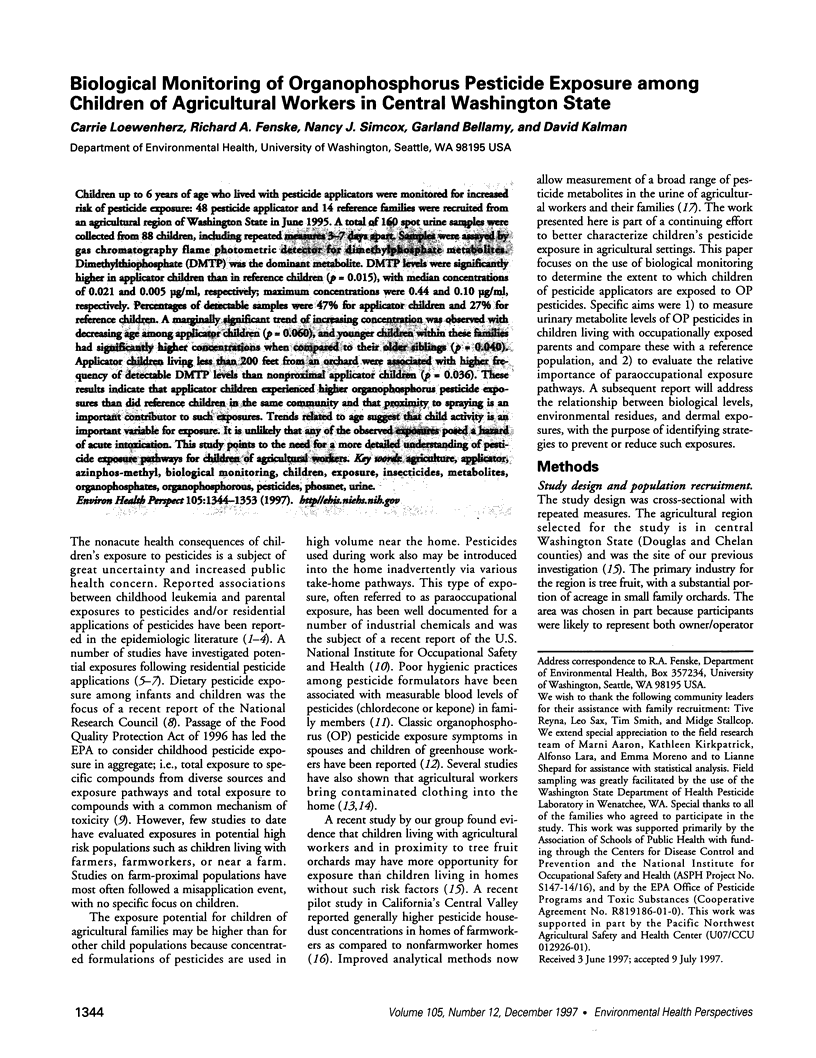
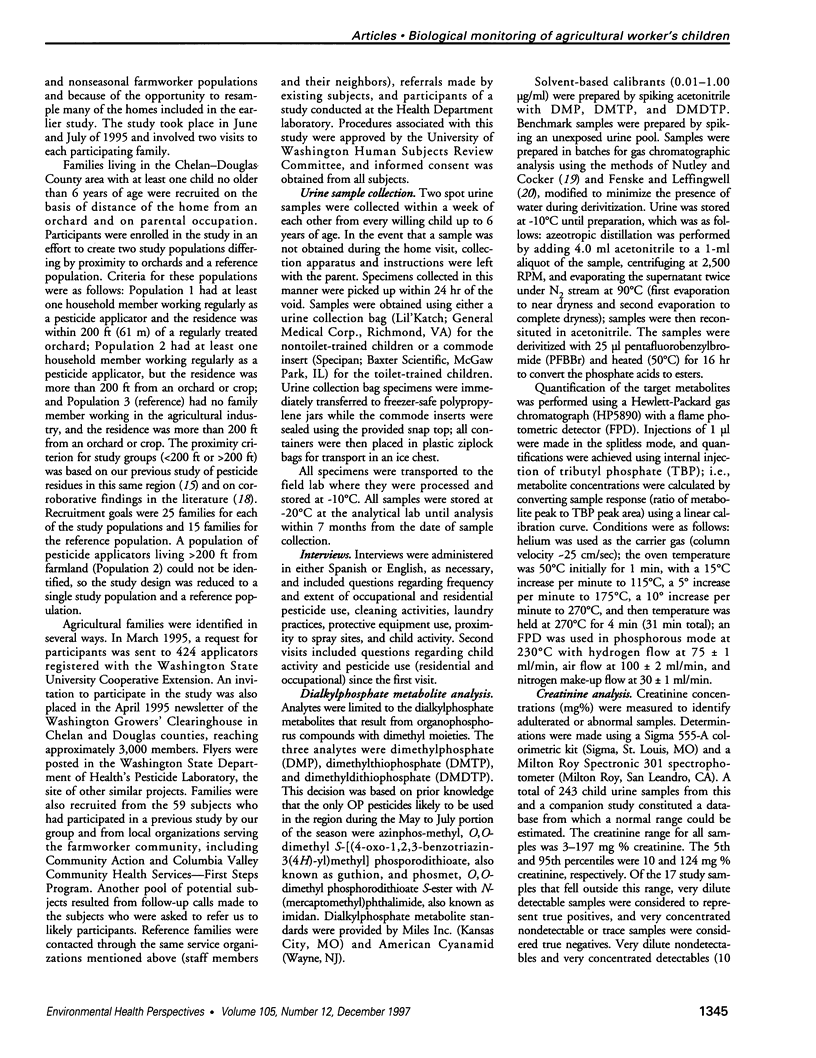
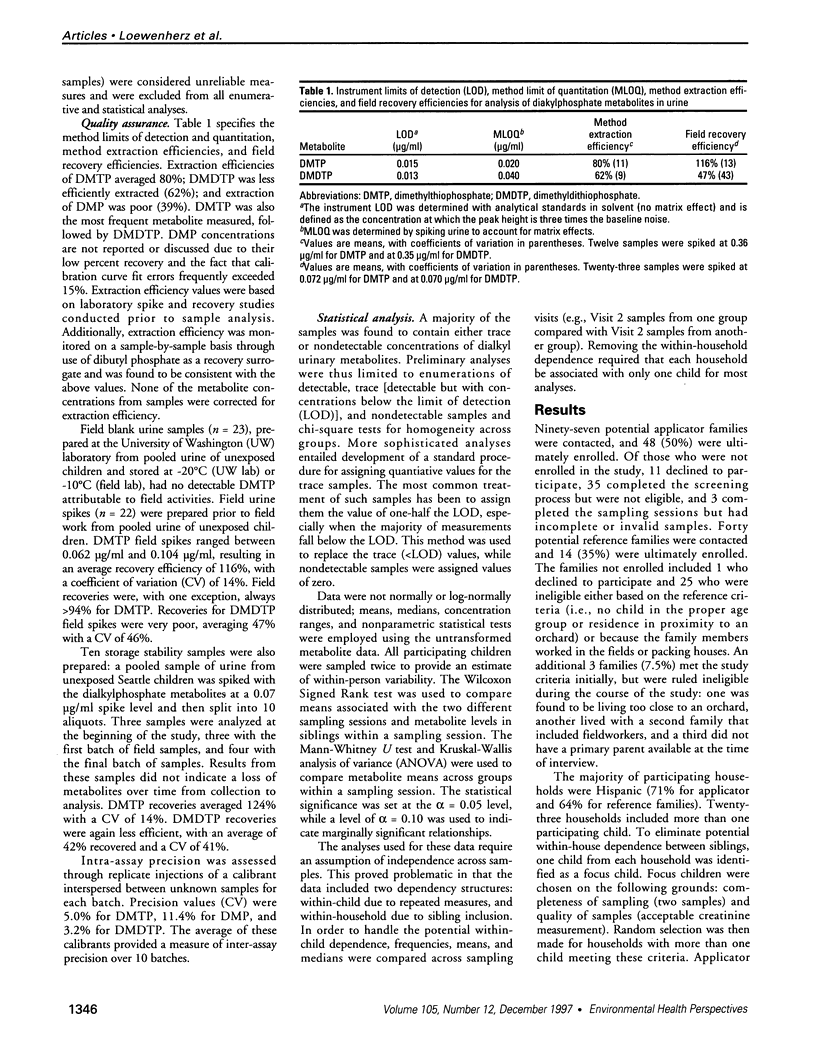
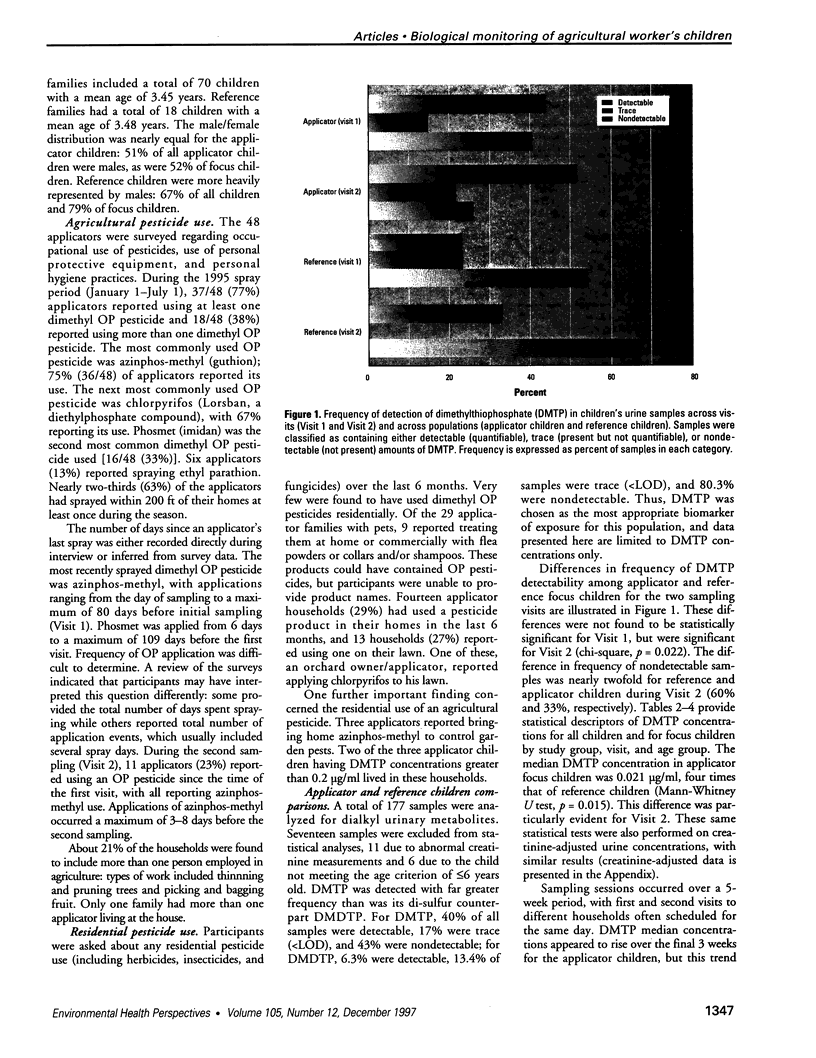

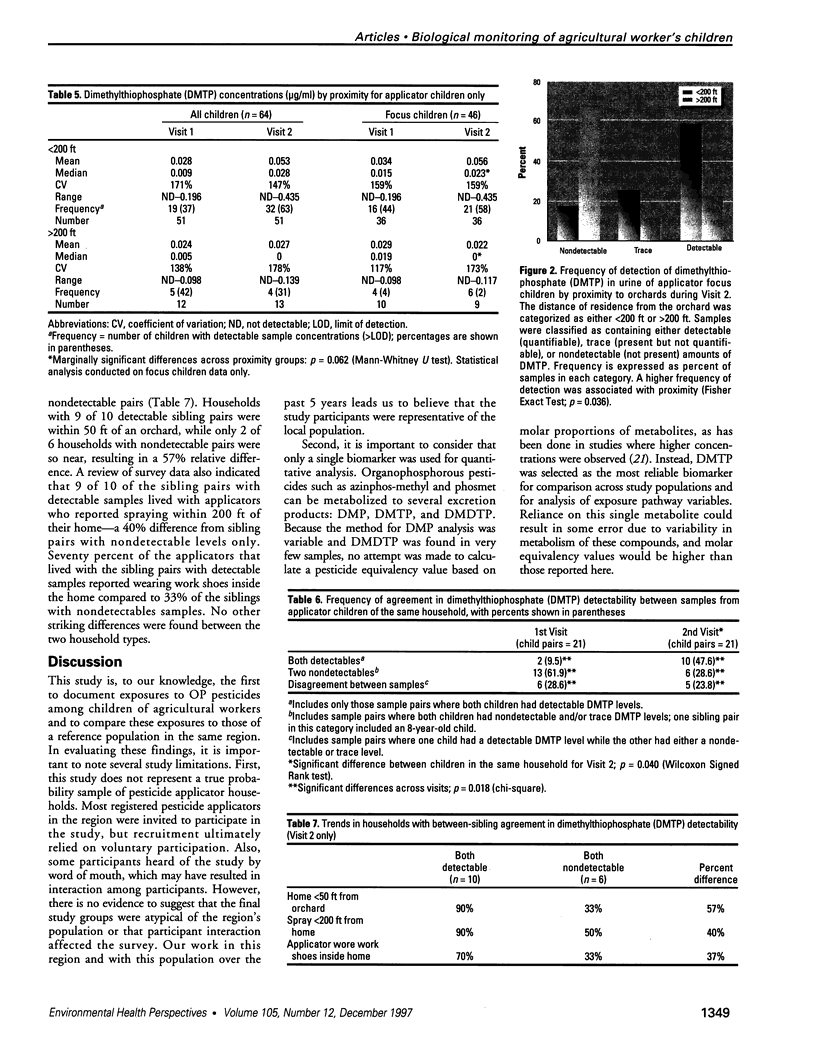


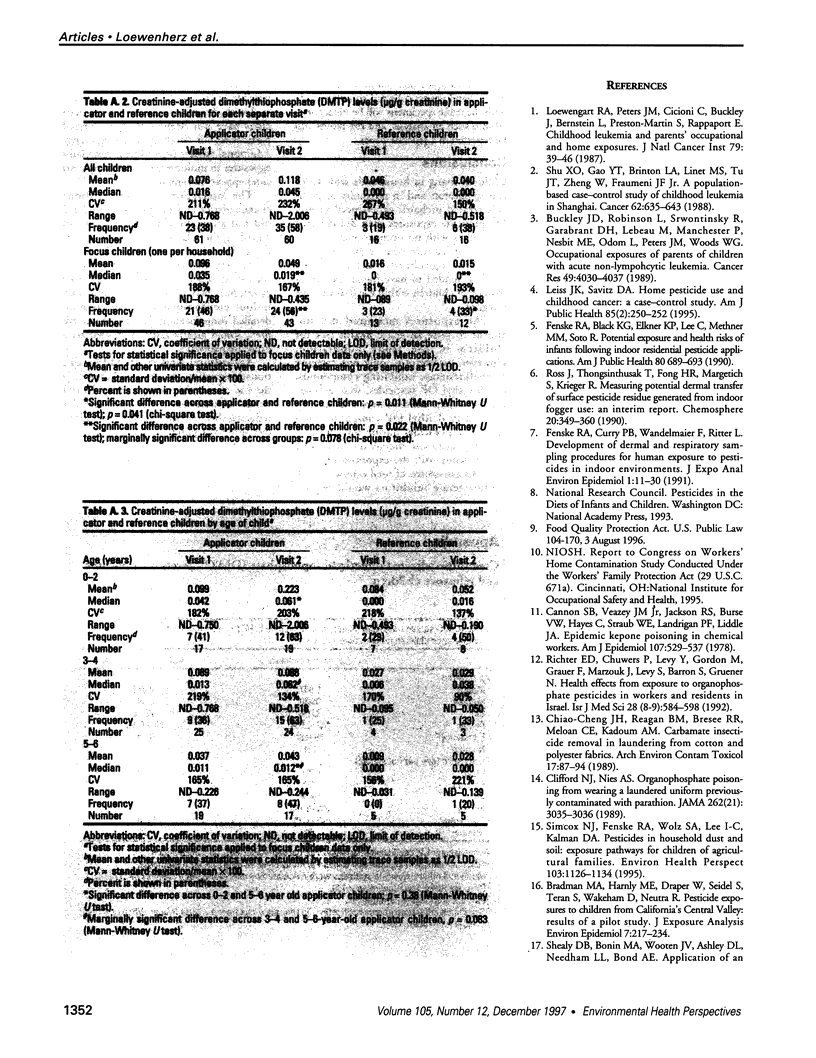

Images in this article
Selected References
These references are in PubMed. This may not be the complete list of references from this article.
- Buckley J. D., Robison L. L., Swotinsky R., Garabrant D. H., LeBeau M., Manchester P., Nesbit M. E., Odom L., Peters J. M., Woods W. G. Occupational exposures of parents of children with acute nonlymphocytic leukemia: a report from the Childrens Cancer Study Group. Cancer Res. 1989 Jul 15;49(14):4030–4037. [PubMed] [Google Scholar]
- Cannon S. B., Veazey J. M., Jr, Jackson R. S., Burse V. W., Hayes C., Straub W. E., Landrigan P. J., Liddle J. A. Epidemic kepone poisoning in chemical workers. Am J Epidemiol. 1978 Jun;107(6):529–537. doi: 10.1093/oxfordjournals.aje.a112572. [DOI] [PubMed] [Google Scholar]
- Chaio-Cheng J. H., Reagan B. M., Bresee R. R., Meloan C. E., Kadoum A. M. Carbamate insecticide removal in laundering from cotton and polyester fabrics. Arch Environ Contam Toxicol. 1988 Jan;17(1):87–94. doi: 10.1007/BF01055158. [DOI] [PubMed] [Google Scholar]
- Clifford N. J., Nies A. S. Organophosphate poisoning from wearing a laundered uniform previously contaminated with parathion. JAMA. 1989 Dec 1;262(21):3035–3036. [PubMed] [Google Scholar]
- Feldmann R. J., Maibach H. I. Percutaneous penetration of some pesticides and herbicides in man. Toxicol Appl Pharmacol. 1974 Apr;28(1):126–132. doi: 10.1016/0041-008x(74)90137-9. [DOI] [PubMed] [Google Scholar]
- Fenske R. A., Black K. G., Elkner K. P., Lee C. L., Methner M. M., Soto R. Potential exposure and health risks of infants following indoor residential pesticide applications. Am J Public Health. 1990 Jun;80(6):689–693. doi: 10.2105/ajph.80.6.689. [DOI] [PMC free article] [PubMed] [Google Scholar]
- Fenske R. A., Curry P. B., Wandelmaier F., Ritter L. Development of dermal and respiratory sampling procedures for human exposure to pesticides in indoor environments. J Expo Anal Environ Epidemiol. 1991 Jan;1(1):11–30. [PubMed] [Google Scholar]
- Franklin C. A., Fenske R. A., Greenhalgh R., Mathieu L., Denley H. V., Leffingwell J. T., Spear R. C. Correlation of urinary pesticide metabolite excretion with estimated dermal contact in the course of occupational exposure to Guthion. J Toxicol Environ Health. 1981 May;7(5):715–731. doi: 10.1080/15287398109530014. [DOI] [PubMed] [Google Scholar]
- Leiss J. K., Savitz D. A. Home pesticide use and childhood cancer: a case-control study. Am J Public Health. 1995 Feb;85(2):249–252. doi: 10.2105/ajph.85.2.249. [DOI] [PMC free article] [PubMed] [Google Scholar]
- Lowengart R. A., Peters J. M., Cicioni C., Buckley J., Bernstein L., Preston-Martin S., Rappaport E. Childhood leukemia and parents' occupational and home exposures. J Natl Cancer Inst. 1987 Jul;79(1):39–46. [PubMed] [Google Scholar]
- Richter E. D., Chuwers P., Levy Y., Gordon M., Grauer F., Marzouk J., Levy S., Barron S., Gruener N. Health effects from exposure to organophosphate pesticides in workers and residents in Israel. Isr J Med Sci. 1992 Aug-Sep;28(8-9):584–598. [PubMed] [Google Scholar]
- Savage E. P., Keefe T. J., Wheeler H. W., Mounce L., Helwic L., Applehans F., Goes E., Goes T., Mihlan G., Rench J. Household pesticide usage in the United States. Arch Environ Health. 1981 Nov-Dec;36(6):304–309. doi: 10.1080/00039896.1981.10667642. [DOI] [PubMed] [Google Scholar]
- Shu X. O., Gao Y. T., Brinton L. A., Linet M. S., Tu J. T., Zheng W., Fraumeni J. F., Jr A population-based case-control study of childhood leukemia in Shanghai. Cancer. 1988 Aug 1;62(3):635–644. doi: 10.1002/1097-0142(19880801)62:3<635::aid-cncr2820620332>3.0.co;2-3. [DOI] [PubMed] [Google Scholar]
- Simcox N. J., Fenske R. A., Wolz S. A., Lee I. C., Kalman D. A. Pesticides in household dust and soil: exposure pathways for children of agricultural families. Environ Health Perspect. 1995 Dec;103(12):1126–1134. doi: 10.1289/ehp.951031126. [DOI] [PMC free article] [PubMed] [Google Scholar]
- Warren M., Spencer H. C., Churchill F. C., Francois V. J., Hippolyte R., Staiger M. A. Assessment of exposure to organophosphate insecticides during spraying in Haiti: monitoring of urinary metabolites and blood cholinesterase levels. Bull World Health Organ. 1985;63(2):353–360. [PMC free article] [PubMed] [Google Scholar]





